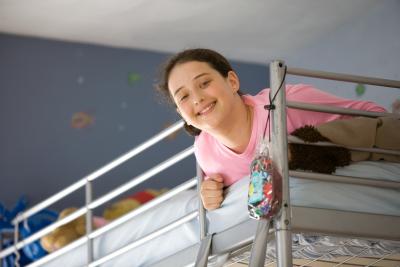Sleep is vital for the good health of your child, but safe sleeping practices are a must if she is going to get a good night’s sleep. This is especially true for infants. Sudden Infant Death Syndrome (SIDS) has been linked to unsafe sleeping environments, according to the National Institute of Child Health and Human Development. Toddlers, preschoolers and even older children can also be affected by poor sleeping habits.
Significance
Sleep gives your child’s body a break. When your child sleeps, cells are busy repairing themselves. The brain, on the other hand, does most of its work while your child is sleeping. It goes to work sorting through memories, replacing chemicals and generally taking stock of the health of the body. Sleep helps your body grow. In fact, too little sleep leads to poor growth and immune system problems, according to KidsHealth.
Benefits
Infants need as much as 16 or more hours of sleep per day. Preschoolers and school-aged children need between nine to 12 hours of sleep at night, according to the University of Michigan Health System. This much sleep is not possible unless you provide a safe sleeping environment for your child. Not only is safety important for your child to rest properly, but safe sleep practices can even save his life. Infant deaths have occurred from babies sleeping on their stomachs, becoming trapped between a mattress and crib rail, and from being smothered under pillows or blankets. Older children have died from bunk bed falls.
Time Frame
Babies should be placed on their backs to sleep, not on their stomachs, until they are old enough to sit up by themselves. Toddlers can be moved to a normal bed or a toddler bed, but a side rail should be used if they tend to roll out of the bed. Water beds should never be used with babies, toddlers or children. Bunk beds are not safe for children under 9, who should never sleep on the top bunk.
Features
Check to make sure your child’s bed is safe. Use a firm mattress and make sure there are no gaps between the mattress and crib rails. Don’t use old cribs or those that motels provide unless you are sure they are safe. The space between the rails may be too large, or the crib may have a drop-down side that can trap a baby. Children under the age of 9 should not sleep on the top of bunk beds, according to the Children, Youth, and Women’s Health services website. Other things in the room may also make for an unsafe sleeping environment. Secondhand smoke, for example, can be dangerous for children — especially when they are sleeping. Blankets, stuffed animals and pillows can also provide a danger for babies and toddlers, as they can cover the face of the child while she is sleeping. Use warm pajamas or a “sleeper bag” for infants rather than blankets.
Considerations
Many children want “cool” beds or features on their beds. Always put safety first when it comes to these things. Netting, for example, may make a princess bed look like a fairy tale, but it can pose a suffocation danger for toddlers if it drapes across the face. A loft bed may save space, but it may also be too high to be safe for young children.





